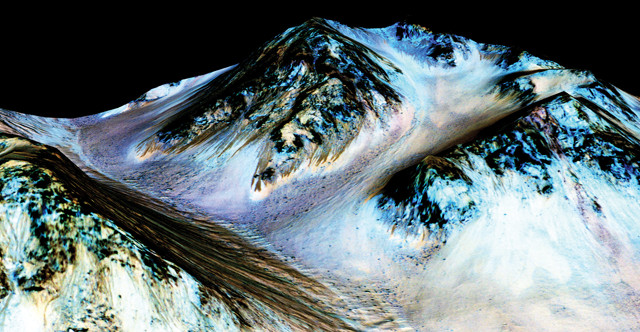
by Timothy Oleson Wednesday, December 23, 2015

The dark streaks in this false-color image, created by draping a two-dimensional photo of the Martian surface over a digital terrain model, are features called recurring slope lineae (RSL). A new study has found that RSL are created by transient flows of salty liquid water. Credit: NASA/JPL-Caltech/Univ. of Arizona.
With two rovers patrolling the surface of Mars, five spacecraft orbiting above it, and scientists here on Earth studying the Red Planet from afar, new findings are announced often. Here are a few of the latest updates.
Researchers studying mysterious dark streaks on Mars’ frigid surface confirmed what has been suspected since the features were first noticed in 2010: The streaks, called recurring slope lineae (RSL), form in the presence of liquid water. RSL’s narrow, channel-like shapes and their appearance only on equatorial slopes during warm seasons led scientists to speculate that the streaks could be formed by water flowing at or just below the ground surface. In a new study in Nature Geoscience, Lujendra Ojha, a graduate student at Georgia Tech who first spotted the RSL five years ago while an undergraduate, and colleagues report spectrometric signals of hydrated perchlorate salts associated with RSL in Hale Crater using data from the Mars Reconnaissance Orbiter (MRO). Perchlorates, which have been previously detected elsewhere in Martian soils, lower the freezing point of water and allow it to remain liquid even when temperatures drop below 0 degrees Celsius. The findings represent “convincing science that validates what we’ve long suspected … that water — albeit briny — is flowing today on the surface of Mars,” said John Grunsfeld, associate administrator of NASA’s Science Mission Directorate, in a statement.
In a new study in Geophysical Research Letters, scientists led by Ali Bramson of the University of Arizona’s Lunar and Planetary Laboratory report finding a large, previously unrecognized reservoir of frozen water just beneath the Martian surface. The researchers deduced the presence and scale of the ice layer — estimated to be about 50 meters thick on average and between 13,000 and 61,000 cubic kilometers in volume — by studying 187 craters in the midlatitude Arcadia Planitia region. Unlike typical bowl-shaped craters, these craters are terraced, indicating the presence of different materials in the subsurface that respond differently to the shock wave of an impact. Combining radar reflection data from MRO with digital elevation models, the team calculated the speed at which the radar waves traveled through subsurface layers, which clued them in to the ice. Based on the ages of the craters, Bramson and colleagues proposed that the layer has existed for tens of millions of years.
Hundreds of small salt deposits on Mars have been observed from orbit, but scientists have struggled to understand how and when the deposits formed. Through detailed study of the topography surrounding one particular chloride deposit, located in an ancient impact basin, Brian Hynek of the University of Colorado at Boulder and colleagues have pieced together an explanation. The basin, in the Meridiani Planum region just south of Mars’ equator, looks like it once held a lake and was fed by flowing rivers. In a study in Geology, the researchers proposed that, when the basin drained, small ponds of water left behind in topographic lows eventually evaporated and left the salts behind. The model better matches other physical features seen in the landscape, such as polygonal fractures like those seen in salt pans on Earth, than explanations involving salt deposition from groundwater, the researchers wrote. Considering the estimated age for the deposit is 3.6 billion years, after most water is thought to have vanished from Mars’ surface, the team concluded that “this and other similar chloride deposits represent some of the last vestiges of habitable surface water on Mars as recorded in the mineralogical record.”
© 2008-2021. All rights reserved. Any copying, redistribution or retransmission of any of the contents of this service without the expressed written permission of the American Geosciences Institute is expressly prohibited. Click here for all copyright requests.